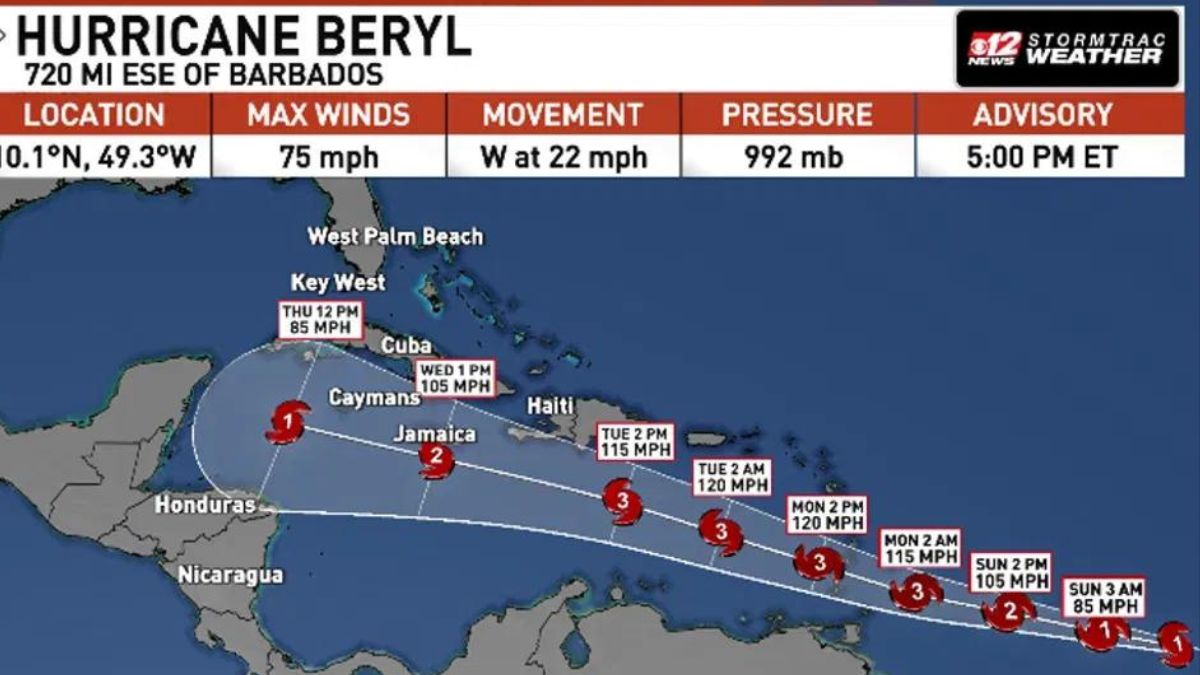Impact on Infrastructure
Hurricane beryl jamaica – Hurricane Beryl brought destructive winds and torrential rains to Jamaica, leaving behind a trail of damage to infrastructure. Buildings, roads, bridges, and other essential infrastructure suffered significant damage, disrupting daily life and livelihoods.
Hurricane Beryl tear up Jamaica bad, but thank God it change course and head straight for beryl barbados. Beryl still strong and dangerous, but Jamaica dodge a bullet this time. We hope our Caribbean neighbors in Barbados stay safe as Beryl pass through.
The hurricane’s strong winds caused widespread damage to buildings, with many losing roofs, windows, and walls. Some buildings even collapsed entirely, including homes, businesses, and government structures. The damage to buildings extended to schools, hospitals, and other critical facilities, affecting access to essential services.
Damage to Roads and Bridges
Hurricane Beryl’s heavy rains caused flooding and landslides, leading to significant damage to roads and bridges. Many roads became impassable, cutting off communities from each other and disrupting transportation. The damage to bridges further exacerbated the transportation challenges, as they are vital for connecting different parts of the island.
Impact on Essential Services
The damage to infrastructure also had a severe impact on essential services. Electricity outages affected large areas, disrupting daily life and businesses. The lack of electricity also hindered communication, as cell towers and other communication systems relied on power.
Water supply was also affected by the hurricane, as water treatment plants and distribution systems suffered damage. This led to water shortages and contamination, posing a significant health risk to the population.
Hurricane Beryl weh dem seh did a come a Jamaica did end up a skirt we. Mi glad seh it neva reach, because wi nuh want nuh storm come mash up wi country. But mi hear seh dem did get some rain inna Puerto Rico , and mi hope seh dem alright.
Jamaica still a watch and wait, because dem seh another storm might a come. But wi a pray seh it nuh reach we.
Specific Examples of Infrastructure Failures
- The collapse of a bridge in the town of Black River, cutting off access to the southern part of the island.
- The flooding of a major highway near the capital city of Kingston, causing extensive traffic delays and economic losses.
- The destruction of a water treatment plant in the parish of St. Elizabeth, leaving thousands of people without access to clean water.
Economic Consequences

Hurricane Beryl caused significant economic losses in Jamaica, affecting both local and national economies. Business disruptions, property damage, and lost tourism revenue contributed to the economic toll.
Business Disruptions
- Businesses were forced to close temporarily due to power outages, flooding, and damage to infrastructure, resulting in lost revenue and productivity.
- Supply chains were disrupted, leading to shortages of essential goods and increased prices.
- The transportation sector was severely impacted, with roads and bridges damaged or impassable, hindering the movement of goods and services.
Property Damage, Hurricane beryl jamaica
- Hurricane Beryl caused widespread damage to homes, businesses, and public infrastructure, resulting in significant repair and reconstruction costs.
- The agricultural sector was heavily affected, with crops destroyed and livestock lost, leading to losses in agricultural output and income.
- Tourism infrastructure, including hotels and resorts, suffered damage, impacting the vital tourism industry.
Lost Tourism Revenue
- Tourism is a major contributor to Jamaica’s economy. Hurricane Beryl caused a significant decline in tourist arrivals, as many travelers canceled or postponed their trips due to safety concerns.
- Hotels and resorts experienced a sharp drop in occupancy rates, leading to lost revenue and job losses.
- Local businesses that rely on tourism, such as restaurants, tour operators, and souvenir shops, also faced reduced revenue.
Environmental Effects: Hurricane Beryl Jamaica
Hurricane Beryl’s destructive force left a lasting impact on Jamaica’s coastal ecosystems. Coral reefs, essential for marine biodiversity, suffered extensive damage, threatening the delicate balance of the underwater world. Mangroves, which act as natural barriers against storm surges, were uprooted and destroyed, leaving coastal communities vulnerable to future storms.
Coastal Ecosystems
- Coral Reefs: The hurricane’s powerful waves and strong currents caused significant damage to coral reefs, breaking apart fragile structures and displacing marine life. This damage can have long-term consequences for fish populations, as coral reefs provide shelter, food, and breeding grounds for various species.
- Mangroves: Mangrove forests, vital for coastal protection, were severely impacted by Hurricane Beryl. Uprooted trees left behind exposed coastlines, increasing the risk of erosion and flooding during future storms. The loss of mangroves also disrupts the ecosystem, affecting the survival of fish, crustaceans, and other wildlife that rely on these habitats.
- Beaches: Hurricane Beryl’s strong winds and waves eroded beaches, causing sand loss and damaging coastal infrastructure. This erosion can alter beach ecosystems, affecting nesting sites for sea turtles and other coastal species.
Flooding and Landslides
The heavy rainfall associated with Hurricane Beryl led to widespread flooding, causing damage to infrastructure, homes, and agricultural lands. Landslides occurred in mountainous areas, blocking roads and disrupting transportation. These events not only pose immediate threats to human safety but also have long-term environmental consequences.
Environmental Hazards
- Pollution: Flooding and landslides can contaminate water sources with sediment, debris, and chemicals, posing risks to human health and aquatic ecosystems.
- Habitat Loss: The destruction of coastal ecosystems and forests reduces the availability of habitats for wildlife, affecting biodiversity and ecological balance.
- Erosion: Beach erosion and landslides contribute to the loss of land and damage to coastal infrastructure, increasing vulnerability to future storms.
